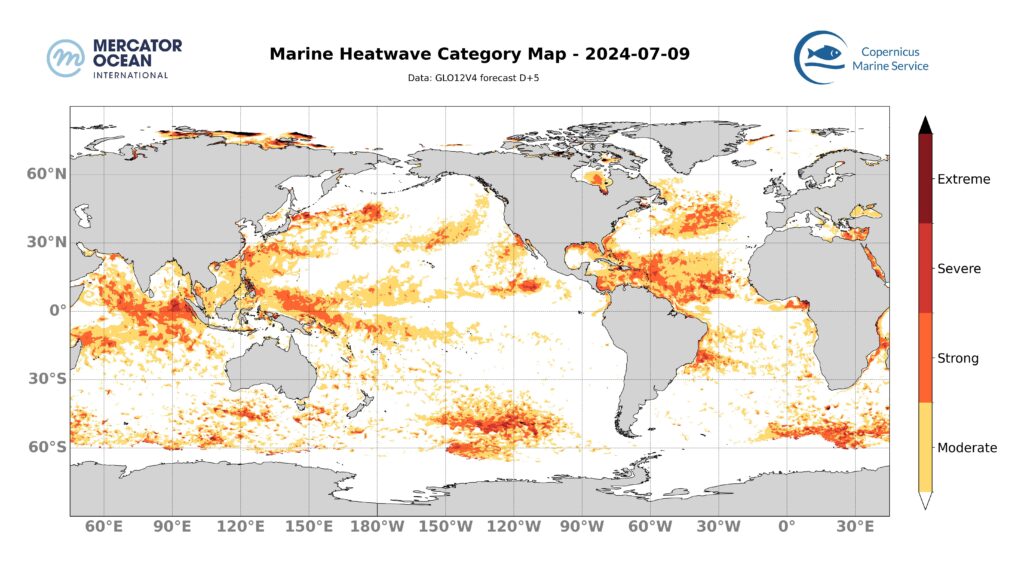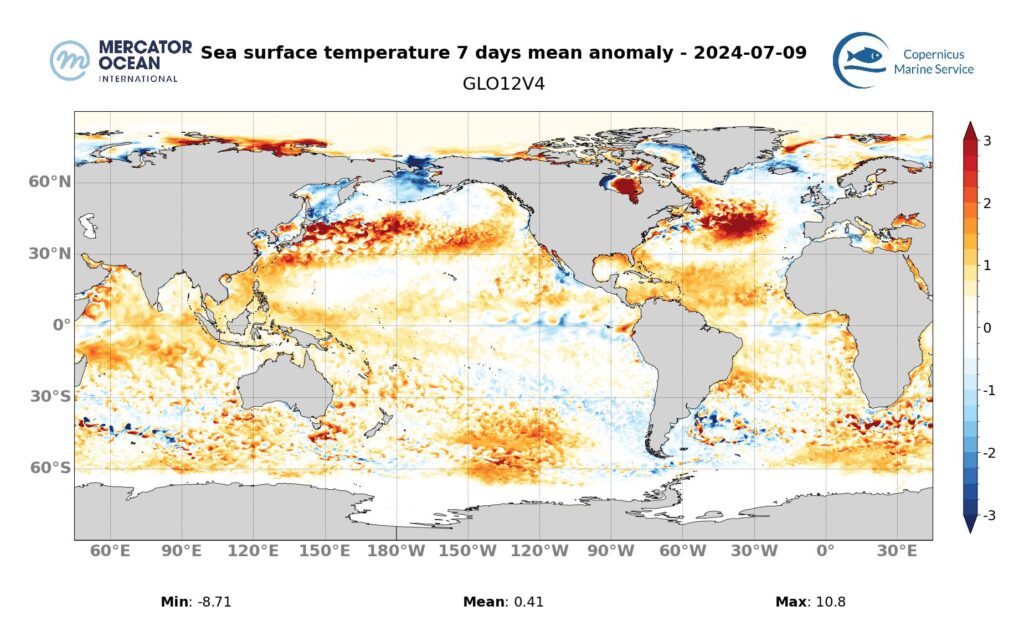Mercator Ocean International (MOi) oceanographers examine marine heatwaves across the global ocean. They analyse a variety of datasets from observations (satellite sea surface temperature maps) to numerical model analyses (assimilating satellite and in situ observations) and derive marine heatwave forecasts for a 7 day period.[1]
Forecasts for July 9th

Europe Zone
For the 09th of July, Mercator Ocean International that in the Mediterranean Sea, the marine heatwave in the eastern part of the basin continues to decrease in extent, but still remains with mostly moderate and strong categories.
Global Ocean
Atlantic Ocean
North Atlantic Ocean – MOi forecasts that the surface of the marine heatwave in the mid North Atlantic is decreases in intensity and becomes predominantly covered by moderate and strong categories.
North Tropical Atlantic Ocean – In the Tropical North Atlantic, the marine heatwave remains stable overall.
South Tropical Atlantic Ocean – In the Southern Tropical Atlantic, the few areas still in marine heatwave conditions remain stable with moderate and locally strong categories.
Southern Ocean
The marine heat wave in the Southern Ocean, off the South African coast (between 30°W and 30°E) stays stable.
Pacific Ocean
Tropical Pacific Ocean – In the Tropical Pacific, the marine heatwave remains globally stable in the west of the basin, with moderate and strong categories. On the Eastern side, along the coasts of California and Mexico, a moderate to severe marine heatwave develops.
North Pacific Ocean – In the North Pacific, between the coast of Japan and around 180°W, the marine heatwave develops with more areas in strong categories, and locally severe categories appear. Between the coasts of Canada and around 170°W, the marine heatwaves remain mainly in moderate categories, but its surface area is increasing.
South-East Asian Seas – The moderate marine heatwave present in the seas of Southeast Asia now covers the entire area, from the East China Sea to the South China Sea, via the Philippine Sea and the Gulf of Thailand.
South Pacific, to the east of New-Zealand – The marine heatwave remains stable.
Indian Ocean
In the Indian Ocean, Mercator Ocean forecasts that the marine heatwave remains stable overall, with moderate, strong and locally severe categories.
Weekly temperature anomalies

| Atlantic Ocean | North 1.5°C to 3°C | North Tropical 0.5°C to 1.5°C | South Tropical 0°C to 1.5°C | |
| Southern Ocean | 0°C to 2°C | |||
| Pacific Ocean | North 1°C to 3°C | Tropical 0.5°C to 1.5°C | South 1°C to 2.5°C | South-East Asian Seas 0.5°C to 1°C |
| Indian Ocean | 0.5°C to 2.5°C |
Consult our Daily Global Physical Bulletin for a 9-day forecast here.
What are marine heatwaves?
Marine heatwaves (MHW) are extreme rises in ocean temperature for an extended period of time. They can occur at different locations in the ocean, and their magnitude and frequency have increased over the last couple of decades, with harmful impacts on ecosystems, and human activities. According to the latest report released by the Intergovernmental Panel on Climate Change (IPCC AR6 SYR), it is found with high confidence that in the near-term at 1.5°C global warming, the increasing frequency of marine heatwaves will increase risks of biodiversity loss in the oceans, including from mass mortality events.[2]
How are marine heatwaves calculated?
A marine heatwave is a heat episode during which the temperature is significantly higher than a certain threshold for at least 5 consecutive days.

Figure adapted from Hobday et al. (2018)
The seasonally-varying threshold is defined on a daily basis according to a sufficiently long climatic period (in this case 1993-2016). So, for a given place and a given day, knowing all the surface temperatures observed over the last 30 years, a heatwave situation is defined as one where the temperature measured is within 10% of the maximum values observed (i.e. above the 90th quantile, see diagram), for at least 5 consecutive days.
The main characteristics of heatwaves are their duration and intensity. The intensity for a given day corresponds to the value in degrees above the 90th quantile (blue arrow), which can either be calculated as the cumulative intensity throughout the heatwave event, or the maximum intensity.
Heatwaves are categorised on the basis of their deviation from the mean temperature or anomaly (green arrow): a deviation of more than 2 times the difference between the 90th quantile and the mean corresponds to a heatwave in the strong category; a deviation of more than 3 times corresponds to a heatwave in the severe category; and a deviation of more than 4 times corresponds to a heatwave in the extreme category.
[1] Analysis of datasets: SST OSTIA (Copernicus Marine Service), OISST (NOAA), GLO12 (Copernicus Marine Service / Mercator Ocean International), PSY4 (Copernicus Marine Service / Mercator Ocean International), and GLO12 et PSY4 forecasts.
[2] IPCC AR6 SYR chapter 4.3 https://www.ipcc.ch/report/ar6/syr/downloads/report/IPCC_AR6_SYR_LongerReport.pdf
